
This week, The Central Board of Indirect Taxes and Customs (CBIC) introduced a new module to check GST returns automatically. This system is able to identify mistakes or differences between various types of tax returns. If such discrepancies are found. assessees will receive a notice informing them about errors.
It works by correlating different returns to detect mismatches to find dispensaries. The CBIC was given the go-ahead to implement the module by the Union Minister for Finance and Corporate Affairs, and it is currently being used to examine GST returns for the 2019–20 fiscal year. This module was released recently along with the ACES-GST Application for Central Tax Officers. To automatically compare and identify flaws in Goods and service tax returns.
The FM Nirmala Sita Raman wanted a technology-based solution for fraudulent cases and ask CBIC to provide solutions following a deep research. This new scrutiny system is designed to improve tax compliance by keeping manual work as little as possible. This will also help the TAX administration to reach its maximum optimum level. The FM also recommended setting up connections with stakeholders in the GST ecosystem to continuously enhance taxpayer services.
The module is made with the goal to give tax authorities the tools they need to thoroughly examine the GST returns of Taxpayers in light of risks and analysis. The module gives tax authorities a medium to communicate with taxpayers via the GSTN Common Portal, They can use FORM ASMT-10 for discrepancies, and FORM ASMT-11 for receiving the taxpayer’s response.
Once the automated scrutiny module identifies discrepancies in GST returns, it enables the tax authorities to take appropriate actions. These actions can include:
- Giving Order of Acceptance (FORM ASMT-12): If the discrepancies are minor or easily resolvable.
- Issuing a GST SCN: In more significant cases of discrepancies or potential non-compliance, the tax authorities may send a show-cause notice to the taxpayer.
- Creating an Audit or Investigation: If the discrepancies are serious or indicate potential fraudulent activities, the tax authorities may initiate an audit or investigation to further examine the taxpayer’s records.
It’s important to note that the Automated Return Scrutiny Module is currently being used to scrutinize GST returns for the fiscal year 2019-20. The necessary data for this process is already accessible to the tax officers through their dashboards.
The purpose of this scrutiny module is to ensure that the information provided in different GST returns is accurate and consistent. By implementing this automated system, the CBIC aims to improve the overall integrity of the GST filing process and enhance tax compliance.
It’s important for taxpayers to carefully review their returns before submitting them to avoid any discrepancies that could potentially lead to receiving notices from the tax authorities.









